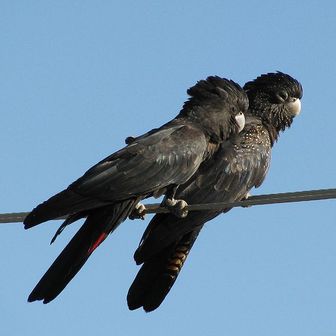Red-tailed Black-Cockatoo
Adult Red-tailed Black Cockatoos are around 60 centimetres in length and sexually dimorphic. Males are completely black in colour, excepting their prominent red tail bands; the slightly smaller females are brownish-black with yellow barring and spotting and have yellow-orange tail stripes. The species is usually found in eucalyptus woodlands, or along water courses. In the more northerly parts of the country, these cockatoos are commonly seen in large flocks. They are seed eaters and cavity nesters. As such, they depend on trees with fairly large diameters, generally Eucalyptus. Populations in southeastern Australia are threatened by the reduction in forest cover and by other habitat alterations. Of the black cockatoos, the red-tailed black is the most adaptable to aviculture,

Original source: originally posted to Flickr as 0804 005 and uploaded to commons as Calyptorhynchus_banksii_(pair)-8.jpg
Author: Calyptorhynchus_banksii_(pair)-8.jpg: gaab22
The Red-tailed Black-Cockatoo is classified as Least Concern. Does not qualify for a more at risk category. Widespread and abundant taxa are included in this category.
conservation status of red-tailed black-cockatoos in south-eastern Australia with special reference to nesting requirements :, Emu, 91(1), 1991, 46–50. * Maron Martine (2005) Agricultural change and paddock tre loss: Implications for an endangered subspecies of Red-tailed Black cockatoo, Ecological Management & Restoration Vol.6, (3); 206-211. More
Red-tailed Black-Cockatoo and is found in the southwest corner of Western Australia between Perth and Albany. This form has a larger bill, and favours Marri (Corymbia (formerly Eucalyptus) calophylla), Jarrah (E. marginata) and Karri (E. diversicolor). * C. b. More
There are 5 subspecies of Red-tailed Black-Cockatoo in Australia. The South-eastern Red-tailed Black-Cockatoo (Calyptorhynchus banksii graptogyne) is only found in south-east South Australia and south-west Victoria. With an estimated population of about 1400 birds, the South-eastern Red-tailed Black-Cockatoo is in danger of extinction. This website relates specifically to the South-eastern subspecies. In this website you can; Find out about efforts to save this beautiful but endangered bird. More
The Red-tailed Black-Cockatoo is a large black cockatoo with a strong bill and large crest. The plumage of the male is black, with bright red tail panels, giving this bird a striking appearance. Female and immature birds have yellow spots on the head, neck and wings, yellowish bars across the chest and a paler red band across the tail. This species can be distinguished from the similar Glossy Black Cockatoo by its greater size, large crest and louder call. More
Program for the Red-tailed Black-Cockatoo Calyptorhynchus banksii in the Northern Territory. Govt. Printer, NT. Pedler, L. 1996. Artificial Nest Hollows for Black-Cockatoos. Eclectus, 1: 13. Pollard, J. 1967. Birds of Paradox. Lansdowne, Melbourne. Primary Industries South Australia (undated). Green Triangle Treefarm Project. Brochure. Read Sturgess and Associates 1995. Supply and Demand Issues in the Firewood Market in Victoria. DCNR, Melbourne. Robinson, D. and Traill, B. 1996. More
The South-eastern Red-tailed Black-Cockatoo, one of five subspecies of the widespread Red-tailed Black-Cockatoo, is classified as endangered and is also the mascot for the 2006 Commonwealth Games being held in Melbourne in March 2006. Also known as the ‘Karak’ after its distinctive call, the Red-tailed-Black Cockatoo is uniquely Australian with a sociable nature making it the perfect mascot for the Games. The total number of birds is about 1000, living in south-western Victoria and south-eastern South Australia. More
the red-tailed black-cockatoo Calyptorhynchus banksii means that rain is on the way, so the birds are a welcome sight. More
(1982) The Red-tailed Black-Cockatoo in south-eastern Australia. Emu 82: 42-45 11. ^ Joseph L, Emison WB, Bren WM. (1991) Critical assessment of the conservation status of the Red-tailed Black-Cockatoo in south-eastern Australia with special reference to nesting requirements. Emu 91: 46-50. 12. More

Original source: User Beilby on en.wikipedia
Author: User Beilby on en.wikipedia
Permission: Some rights reserved
Family : Psittacidae
Genus : Calyptorhynchus
Species : banksii
Authority : (Latham, 1790)
